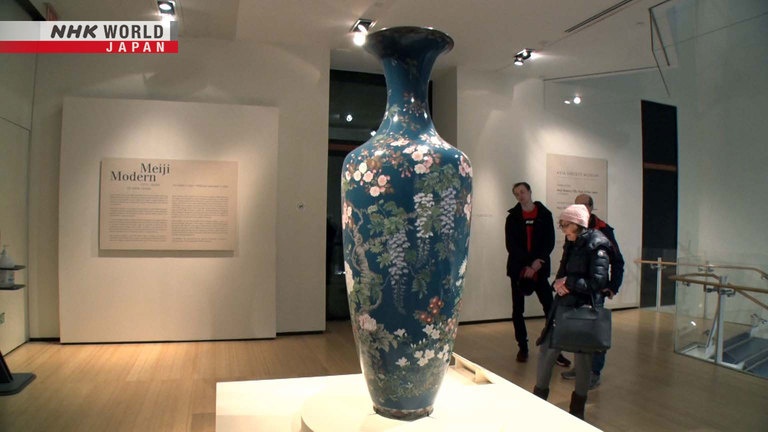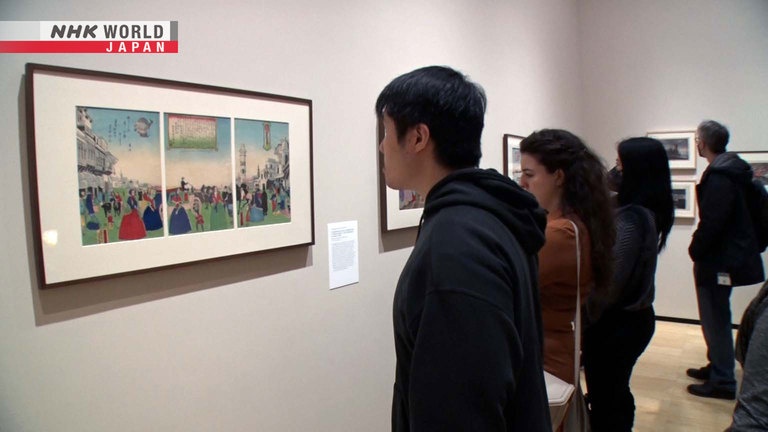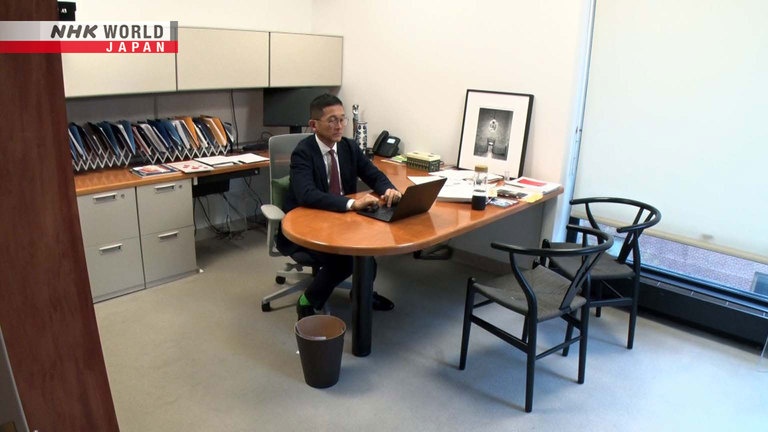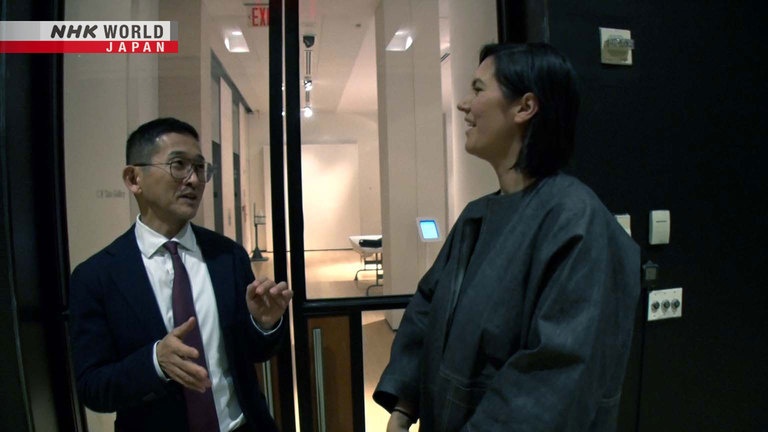Building a Transformative Museum for Asian Art: Yasufumi Nakamori / Director, Asia Society Museum
Yasufumi Nakamori, Director of New York's Asia Society Museum, talks about expanding the reach of Asian art, while recognizing the colonial roots of western museums and the importance of diversity.




Transcript
Direct Talk
At the Asia Society Museum in New York City,
the exhibition,
"Meiji Modern: 50 Years of New Japan,"
opened in October 2023.
It formed a central part of The Asia Society's
year-long program, the "Year of Japan,"
commemorating the 170th anniversary
of the arrival of the American
Naval officer Matthew Perry.
That historic event of 1853
opened feudal Japan to the West
and brought about its rapid
modernization under the Meiji emperor.
This exhibition of artworks created
during 50 tumultuous years of globalization,
put a spotlight on an era
which had long been overlooked.
Nakamori Yasufumi has been spearheading
programs at the Asia Society Museum
as museum director since August, 2023.
Asian art in America is relatively new,
particularly modern contemporary Asian art,
and Asia Society Museum has been the leader,
So, I want to continue
that tradition, certainly.
But I want to also challenge
and also expand what Asian art is.
We ask Nakamori Yasufumi
about the museum's role in raising the profile
of Asian art in the global conversation.
Building a Transformative Museum for Asian Art
Asia Society Museum was established in 1956.
And since then, you know,
we have created more than 250 exhibitions,
showing Asian and also Asian diaspora art.
And as a director, I set forth visions
and directions of the museum moving forward.
We want to show the diversity and
complexity of Asian art, Asian diaspora art.
We also want to look at the intersection
between Asia and the rest of the world.
Looking at the gaps in the history
of Asian art through exhibition,
we are identifying what are the areas
we need to really bring to
the people's visions and also thinking.
At the entrance of the
Meiji Modern exhibition
stands a giant Cloisonne enamel vase,
commissioned in the mid-1890s, by an American.
The technique, known as "Shippoyaki,"
flourished during the Meiji period
thanks to interest from abroad.
When Japan ended its policy of isolation,
it felt as though the country was
being led into unknown territory.
This transformation is
reflected in many artworks,
showing the introduction of western
customs, dress and modern technology.
Exhibition of Meiji art
has not been done often.
This may be the first
of this scale in America.
When we think about Japanese art,
we often refer to,
Tokugawa you know, era right, Edo period
or even you know, before then certainly.
So, Meiji was a little too new
for scholars to dive in until recently.
Previously people tend to think that
there was a lot of copy,
you know, from earlier period,
or, you know, relatively sort of, like,
you know, bad quality of imitations
of some kind from the west.
But that's not the case at all.
I mean, there's incredible
craftsmanship and also originality,
and modernity you see
in many objects in exhibition.
These ceramic busts of
American Founding Fathers
George Washington and Benjamin Franklin
reflect Japanese artists' new global outlook,
as their market expanded beyond Japan.
The image on this panel looks like
a photograph from the West,
but it's embroidered with silk threads,
in about 250 shades of blue and grey,
using a traditional Japanese technique.
Self-portraits by Onchi Koshiro,
internationally acclaimed
for his printmaking,
show him experimenting with oil paints
after they were introduced
to Japan for the first time.
I think many, many works in exhibitions
were a surprise to many visitors.
There's a beauty.
There's also dynamism.
And also, how Japanese artists
looked at tradition,
traditional values,
the past history of Japan,
but then instead of staying there, they really
advanced to make a new work, modern work.
So, that, you know, conflict or tension
between the past and now, right,
that really was the engine
for many artists to create a new work.
The Meiji Modern exhibition has introduced
a new and more diverse audience
to the appeal of Japanese art and crafts.
Each piece was sort of
exquisite and special, and
that's what I got to experience today.
Beautiful Japanese art,
and it's a really fine show.
You can see influences in
modern entertainment, like in anime.
I see influences from Meiji art,
and I thought that was cool.
I didn't know there was a connection.
Museums are at their best
when they reflect ideas, changing ideas,
you know, ideas in transformation.
I guess, you know,
through showing the works of art,
museum should really take a role, predicting
what may happen, or how society could change
through the dialogue we create
from museum space.
Nakamori Yasufumi was born in Osaka, Japan.
His father was an accountant,
who loved art and often visited museums.
We saw many, numerous exhibitions
together, my father and myself.
I grew up in a family where
there was an encyclopedia of,
you know, art history, for example.
That influence was impactful.
After graduating from college,
Nakamori moved to the United States.
In search of a stable career,
he studied public policy and law.
For seven years, he worked as a
corporate lawyer in New York and Tokyo,
until a fateful day in 2001.
In the morning of September 11th,
I was supposed to fly to Tokyo,
and I was on my way to catch
a shuttle bus from World Trade Center,
that's where the bus
comes and goes, around 8:45,
and one minute after I arrived,
the first plane hit the North Tower.
So,
that really kind of shocked
the core of all of us, right?
All of New Yorkers.
I felt that life can be cut short,
therefore, I should really pursue my passion.
Nakamori quit his job and returned to college
to earn a Ph.D. in art history.
After working as a curator
at two museums in the US,
he became a senior curator
at The Tate Modern in London,
one of the most renowned
museums in the world.
There, he joined the first cohort of
the Tate's Race Equality Task Force,
which set out to bring diversity
to the museum's collection.
This issue of equity, and diversity
is very important in the field of
art museums, any museum actually.
Art museum is really a colonial construct.
The way we start museum,
we started museum anywhere
is to collect and show work of art,
often, you know, taken from
their colonies, right?
Or places, exotic places for, you know,
foreign travelers, people who collected art.
I think Tate, actually, is one of the,
you know, first museums, I think,
that really considered that
colonial history and then
reflect and think hard, how we can
make changes in the way we operate
how we collect, what we collect,
who we show in the museum space,
and who work at the museum.
You know, I mean, if you look at
the sort of like curators, right?
You know, curators often, you know,
white, you know, privileged people.
Look around. How many black curators
are there in New York City museums?
Just teeny.
Look around.
How many Asian, you know, art curators,
Asian art museum directors are in America?
Just small.
So that's actually the task,
you know, we are being faced,
and we have to make an actual improvement.
Global majority are Asian, and also,
you know, black, and Latinos.
So we need to really reflect
that proportions to be collected,
and also reflected in a space of art as well.
Nakamori left The Tate Modern to become
the Director of the Asia Society Museum.
He felt a renewed mission
to bring his expertise on race and equality
to this globally important Asian art museum.
For the "Year of Japan," he programmed
a series of conversations
with Japanese artists
active in the global art scene,
such as this acclaimed
New York City-based photographer.
It's so honor to be here
with Hiroshi Sugimoto.
The title is "Time Machine."
Why did you title that?
It's a kind of weird title, but I consider
my camera as a time machine.
I think Japan has kind of slipped out
of the superpowers in a cultural space.
Japanese government doesn't do
much of promotion, A, unlike Korea.
How many Japanese artists
are outside of Japan?
Or how many curators, how many scholars,
you know, work on Japan are outside of Japan?
I think Japan has become
kind of one of the islands again.
People are not,
they are not coming out of it.
They feel too comfortable being in Japan.
That's why we felt
we should do this program
to bring the relatively unknown
kind of critical aspects of Japan,
outside of the box,
and then give a light to it.
So in that sense,
it's an ambitious reflection,
and critique, and re-imagination
of many aspects of Japan.
After showing in New York, The Meiji Modern
exhibition moved on to Chicago and Houston.
Nakamori has shifted his focus to creating
a 5-year strategy for the Asia Society Museum,
to show exhibitions that will shine
new light on Asian and Asian diaspora art.
We do have a very important collection
of traditional, pre-modern Asian art.
So, we're thinking how we can bring those,
you know, traditional art back
to the galleries with a new light.
So, I want to bring in contemporary artists
to look at those collections together
and to bring those works to the galleries.
I also want to bring in
Asian American art into the dialogue.
I also want to bring in
indigenous art in Asian art.
So, you know, artists who are indigenous,
you know, Asian heritage,
So, I'm just kind of re-mapping, you know
and then kind of, you know,
positioning where we want to stand
and how we can kind of create comprehensive
planning for the exhibitions and programs.
And the programs
need to be popular certainly,
but also have to have a scholarly merit.
We asked Nakamori Yasufumi
to share his motto.
So, I wrote,
"Believe in one's transformative power."
Everyone has transformative power,
that can be you know, act of kindness,
your courage, or your painting.
I believe in that power
in person, in myself,
in work of art, in writing, a piece of music.
So, art can make some great,
you know, changes in the world.